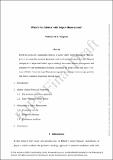Files in this item
What's the matter with super-Humeanism?
Item metadata
| dc.contributor.author | Simpson, William | |
| dc.date.accessioned | 2021-06-30T23:35:37Z | |
| dc.date.available | 2021-06-30T23:35:37Z | |
| dc.date.issued | 2019-07-01 | |
| dc.identifier | 268255596 | |
| dc.identifier | c2d1b81a-c025-4a93-bdc3-67f92c1a6757 | |
| dc.identifier | 85118992522 | |
| dc.identifier.citation | Simpson , W 2019 , ' What's the matter with super-Humeanism? ' , British Journal for the Philosophy of Science , vol. In press , axz028 . https://doi.org/10.1093/bjps/axz028 | en |
| dc.identifier.issn | 0007-0882 | |
| dc.identifier.uri | https://hdl.handle.net/10023/23459 | |
| dc.description | The author would like to acknowledge the financial support of Peterhouse (Cambridge) in the form of a Blacker–Loewe Doctoral Studentship in Philosophy. | en |
| dc.description.abstract | Esfeld has proposed a minimalist ontology of nature called ‘super-Humeanism’ that purports to accommodate quantum phenomena and avoid standard objections to neo-Humean metaphysics. I argue that Esfeld’s sparse ontology has counterintuitive consequences and generates two self-undermining dilemmas concerning the nature of time and space. Contrary to Esfeld, I deny that super-Humeanism supports an ontology of microscopic particles that follow continuous trajectories through space. | |
| dc.format.extent | 205521 | |
| dc.language.iso | eng | |
| dc.relation.ispartof | British Journal for the Philosophy of Science | en |
| dc.subject | B Philosophy (General) | en |
| dc.subject | T-NDAS | en |
| dc.subject.lcc | B1 | en |
| dc.title | What's the matter with super-Humeanism? | en |
| dc.type | Journal article | en |
| dc.contributor.institution | University of St Andrews. School of Divinity | en |
| dc.identifier.doi | https://doi.org/10.1093/bjps/axz028 | |
| dc.description.status | Peer reviewed | en |
| dc.date.embargoedUntil | 2021-07-01 |
This item appears in the following Collection(s)
Items in the St Andrews Research Repository are protected by copyright, with all rights reserved, unless otherwise indicated.

